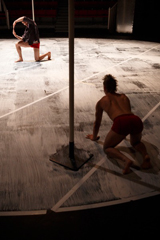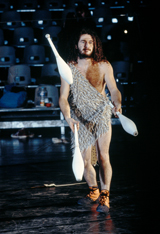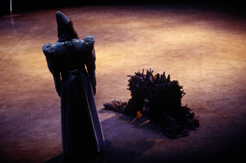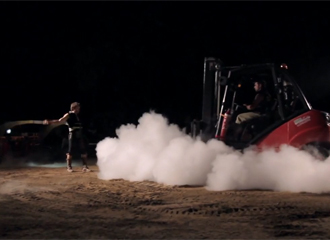by Pascal Jacob
A major axis of definition of a certain type of circus, the training, dressage and presentation of wild animals have contributed since the end of the 19th century to make many European, American or Australian shows a eulogy of exoticism and a mirror of colonialism. The fascination for a distant land elsewhere has long been used as a catalyst for the operation of companies engaged in a frenetic race towards exceptional feats. From the second half of the 19th century onwards, tens of thousands of wild animals helped to build a huge landscape that was in turn docile and roaring, but the awareness of Western societies in the early 1970s, combined with the development of wildlife protection laws, made this universe even more vulnerable and moved it further into the margins of other forms of entertainment.
Curiosity has changed, the public's awareness and perception have evolved, and while the live animal continues to arouse amazement, it now also stirs up a host of contradictory emotions about its condition and status on a ring or on a stage. From the 1970s onwards, the principle of dressage gradually fades away, both in favour of a simple presence of a wild creature, as an expression of nature and a response to a strong desire for imagination, but also by creating substitute, stylized or hyper-realistic replacement silhouettes.
The notion of evocation is crucial to understand the effects of a mutation that began in the late 1990s. The creativity of the companies is endless and the creations that quote or emphasize the importance of interpreted animals flourish. The Giraffe hunters of the Royal de Luxe Company in 2000 transgressed the norm by inviting in the public space some real oversized and "living" sculptures, animated by clearly visible manipulators, in the spirit of a revisited bunraku. In 2003, the Sugar Beast Circus, "undisciplined circus" according to its founder Geneva Foster Gluck, plays with the codes of a circus extremely steeped in conventions, using oversized lions’ masks to develop humorous sequences in counterpoint to powerful images. A form of fantasy that the Théâtre de la Licorne integrates with Le Bestiaire forain in 2002 or Les Encombrants font leur Cirque directed by Claire Dancoisne in 2012. The rhinoceros designed for this show is a formidable animated, enormous and mobile silhouette, both touching and impressive, but also very effective in anchoring the show to the circus and exhibition universe.
Towards abstraction
Shaped in recycled rubber imported from Kenya, the animals of Cirkafrika, a show from the Phoenix Circus created by Alain M. Pacherie, are crafted in a small workshop in Dar es Salaam, Tanzania. The animals are inspired by the emblematic creatures of the African savannah, oscillating from one piece to another between realism and stylisation, mixing vegetal fibres, paint and rubber to create an offbeat menagerie, but whose residents are always perfectly identifiable. A crocodile and two elephants that really look and sound the part, a turtle and a giraffe with straight tones, but with a look that is more ironic than realistic, an antelope that is fairly accurate in terms of colours and proportions, and two other giraffes, designed more like silhouettes and dance supports with long skirts adorned with raffia, complete a joyful and festive ensemble. The parade of these animals is an echo of an ancient practice in which the clowns gave pride of place to partners made of painted rags to create light parodies with false horses or, in the case of the Fratellinis, a cow with devastating eyes for a bullfight with Elizabethan accents. When a picador's horse was ripped open, he left a string of cloth viscera on the ring, a theatrical realism resembling the red cloth that the actors of the Globe, Rose or Swan surreptitiously spouted out of their doublet to signal a wound. These dummy animals, realistic but without excess, are also the ancestors of the characters created by Julie Taymor for the stage adaptation of The Lion King on Broadway. Animated from the inside, they thus acquire a capacity for new movement, but still belong to the figurative register. They show the same fascination for imitation and resemblance, for performance and mismatch with the living, sometimes even osmosis between body and skin, muscles and shell, between the actor and the creature he animates.
The slide towards a form of abstraction in the representation of wild animals is a seductive mutation that occurs gradually. The beast becomes metaphorical. Les Oiseaux du Cirque Réinventé, a Cirque du Soleil show where the taste for animality is also expressed in a collective of seesaws where acrobats evoke stylised penguins, suggest a first shift. The essential characteristics of the animal are respected, but it soon becomes clear that a simple pile of fabrics can be as powerful as… a living animal! The elephant imagined and designed by Victoria Chaplin for Raoul, a show by James Thiérrée created in 2012, is part of this singular magic, when an apparently abstract form comes to life and becomes a wide-open window into the imagination. This dissolution of what is real is even stronger with a process of assembling disparate elements, such as a velvet corset associated with two chandeliers and a large piece of fabric to create the appearance and give "life" to a moose with impeccable lines and confounding accuracy. This visual construction principle, where nothing is given in advance to the spectator, determines another trepidation threshold for animality on a ring or a stage.
In a similar but offbeat vein, in 2015 the Catalan company Animal Religion creates Tauromaquina, an acrobatic and choreographed bullfight, in which the beast is embodied by a forklift truck whose blades accurately portray the sharp horns of the bull. The engagement is strong, the wheels of the machine blow the dust of the arena around and the balance of power between man and machine is sometimes much more than a simple evocation to the point that we sometimes end up believing it...
The process of dissolving the appearance, the abolition of clear signs of identification of any real beast, the implementation of a suggestive form of pure blueprint, finds its full resolution in 2002 with the parody of dressage of a suggestive creature with the appearance of a canvas monster, an enormous inflatable structure, of a perfect matte grey and similar to an elephant skin, "tamed" by Bruno West in the ring of the Cirque dans les Etoiles. A suggestive creature, the Beast is in turn, according to imaginations similar to an elephant or an elephant seal, a hippopotamus or a rhino, but also, why not, a construct of the mind, abstract and figurative at the same time. Nothing identifies a specific animal, but all the representation codes are respected and the light weight of the object, compared to the size of the tamer with all the attributes of the function, leaves little doubt. It is indeed a "beast", unforeseen and unpredictable, ferocious perhaps, and definitely exotic.
Mutations and changes
This indecision also marks the unlikely two-headed beast imagined for La Tribu Iota, a show from the 12th Centre National des Arts du Cirque (National Circus Arts Centre) in Châlons-en-Champagne produced by Francesca Lattuada. A strange silhouette that could either be a dog or a bear, but that unsurprisingly never fails to surprise everyone... The following promotion with the Cyrk 13 show directed by Philippe Decouflé humorously integrates a contemporary figure of the tamer by playing with a plush stuffed tiger carried on the shoulders of Gaël Santisteva as Claire Héliot or Eugène Weidman used to do with their real wild animals.
The Cirque Plume circus features another, even more indistinct animal, embodied by a group of red umbrellas, kept in check by a clever and convincing trainer with a jet of water. When this blood-red unit moves forward on the Plic Ploc stage, the public holds its breath, both surprised and amazed: on its own, the umbrella is harmless. As a group, it becomes frightening, capable of swallowing the reckless trainer who approached it carelessly. This heap of everyday objects, transcended by the imagination of the director and the public alike, is a marvellous way of erasing the wild animal for the benefit of all the creatures of the Creation, gathered without limits or contours in a joyful construction full of fantasy. The moving structures invented by Johann Le Guillerm for his successive creations belong to the same register: endowed with a life of their own by the interplay of subtle assemblages, without cogs or complex mechanisms, they are the result of a disconcerting organicity. Escaping from a contemporary cabinet of curiosities, they are supported by an exceptional creative inspiration drawn from the same sources as those behind exhibition and diversion.
This form of abstraction, elaborated and assumed, could mark the definitive decline of any other form of representation, but the animal is tough and, like the circus, it knows how to be multifaceted: In contrast to Rasposo company's or Circus Plume's creations, the Christmas show at the Circo Price in Madrid in 2016 caused a real stir with a number of totally dummy polar bears, but made with a meticulous attention to detail bordering on hyper-realism. Between provocative innovation and subtle twists and turns, these life-like animals, capable of creating a lasting illusion by being carefully lit, are a fun way to disrupt cards that we thought had already been dealt. This proximity effect, like a formidable shortcut between man and the wild animal, the expression of a distortion of a reality that is now impossible to assume any longer. Ultimate twists and turns of history, the "trained" marabout of The Dromesko Aviary or the integration of a training sequence with a "real" tiger as the conclusion of the Morsures show, stigmatize this intuitive and complex relationship that man has maintained with the living since the dawn of time. With this wild animal, Marie Molliens renews the dialogue with a discipline that has been rejected or forgotten by the successive trends of the New Circus, the contemporary circus or the accepted hierarchy of the Circus Arts. The Rasposo Company has regularly incorporated live animals into its shows, but the intrusion of a wild animal significantly pushes the cursor on the acceptance scale. With La Dévorée, Marie Molliens again, restores to Barzoïs greyhounds their part of original savagery and introduces a singular violence in her images. This game with history, between brutal shortcut and allegory, is embodied by this animal with a particular density. An echo much more than a continuity.

















